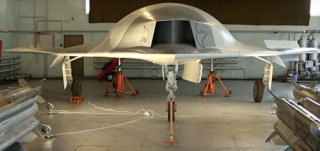Is This Russia's Next 'Stealth' Threat?
In late January 2019, the world got its first good look at Russia’s first stealth unmanned aerial combat vehicle (UCAV), the Okhotnik-B.
In late January 2019, the world got its first good look at Russia’s first stealth unmanned aerial combat vehicle (UCAV), the Okhotnik-B. The Okhotnik is not an unknown project, but earlier looks at the platform only came in mockups and renders, not in a functional configuration.
However, the aircraft seen on the runway in late January is not flight-ready just yet. The UCAV is said to be undergoing runway tests prior to flight tests, which are expected to occur later in 2019.
The Okhotnik-B is a flying wing stealth UCAV that shares a lot of technology with Russia’s new Su-57 fighter. In combat, it could augment the capabilities of the Su-57 by providing additional sensing capability and carrying additional munitions.
The ability for the Su-57 and Okhotnik to cooperate was teased on the tail art of a Su-57 prototype. Some attribute this art to the fact that the Okhotnik’s avionics are being tested onboard the Su-57 due to delays in getting the Okhotnik itself flying, but Russia has expressed the desire for the Su-57 to act as an UCAV control station before, mirroring the F-35’s projected ability to control UCAVs of its own.
The Okhotnik is a flying-wing design, similar to earlier American and European stealth UAVs like the American RQ-170. Unlike American stealth designs, it features a large conventional metal thrust nozzle for its engine, which would presumably have a large radar-cross section from the rear aspect. The nozzle does appear to be gimballed for thrust-vectoring functionality, so it’s possible that the Okhotnik might be prioritizing maneuverability over stealthiness. It’s unsure if this large nozzle will be retained on the final version of the Okhotnik, or if it only a placeholder for testing.
The actual loadout of the Okhotnik is unknown, but Russian watchers have speculated that the Okhotnik will carry ordnance inside two weapon bays inside the wing, to either side of the engine. This would give the Okhotnik rough parity to the F-35 in carriage capacity for weapons, as the F-35 is also only capable of carrying two missiles internally.
As far as sensors go, the Okhotnik seems to carry a similar setup to most Russian fighters. What appears to be an infrared search and track (IRST) sensor package is visible on the right wing of the Okhotnik, and the UCAV is likely equipped with a radar.
The IRST and thrust vectoring of the Okhotnik suggest that the UCAV could be designed to be extremely deadly in a close range “knife fight” UCAVs are not restricted by a human pilot in how many Gs they can pull, so presumably the thrust vectoring features could allow the UCAV to outturn manned fighters in a dogfight, after using IRST to close to short range without activating radar warning receivers.
While this scenario may not be likely to succeed on aircraft with their own distributed optoelectronic sensors, such as the F-35, it could be a very real threat to older aircraft or those without that feature.
Regardless, the “priority” given to the Okhotnik suggests that Russia is taking its new UCAV program very seriously. Combined with the official adoption of the Uran-9 unmanned ground vehicle, the Russian military seems to be pushing for a more and more roboticized force with which to fight future wars.
The reason for this roboticization can possibly be explained by another nation, Israel. Israel found that the use of UAVs could keep the political dissent of fighting wars lower despite its usage of a conscript military, because conscripts manning UAVs were not directly sent into harms way. Russia could be looking at UAVs and UCAVs for similar reasons.
However, the Okhotnik is unlikely to be flown by conscripts, given that it is looking to be an air-combat oriented, expensive piece of hardware. UCAVs are looking to be the deciding factor in future aerial warfare, and Russian wants to be one of the first there.
Charlie Gao studied Political and Computer Science at Grinnell College and is a frequent commentator on defense and national security issues.
Image: YouTube

